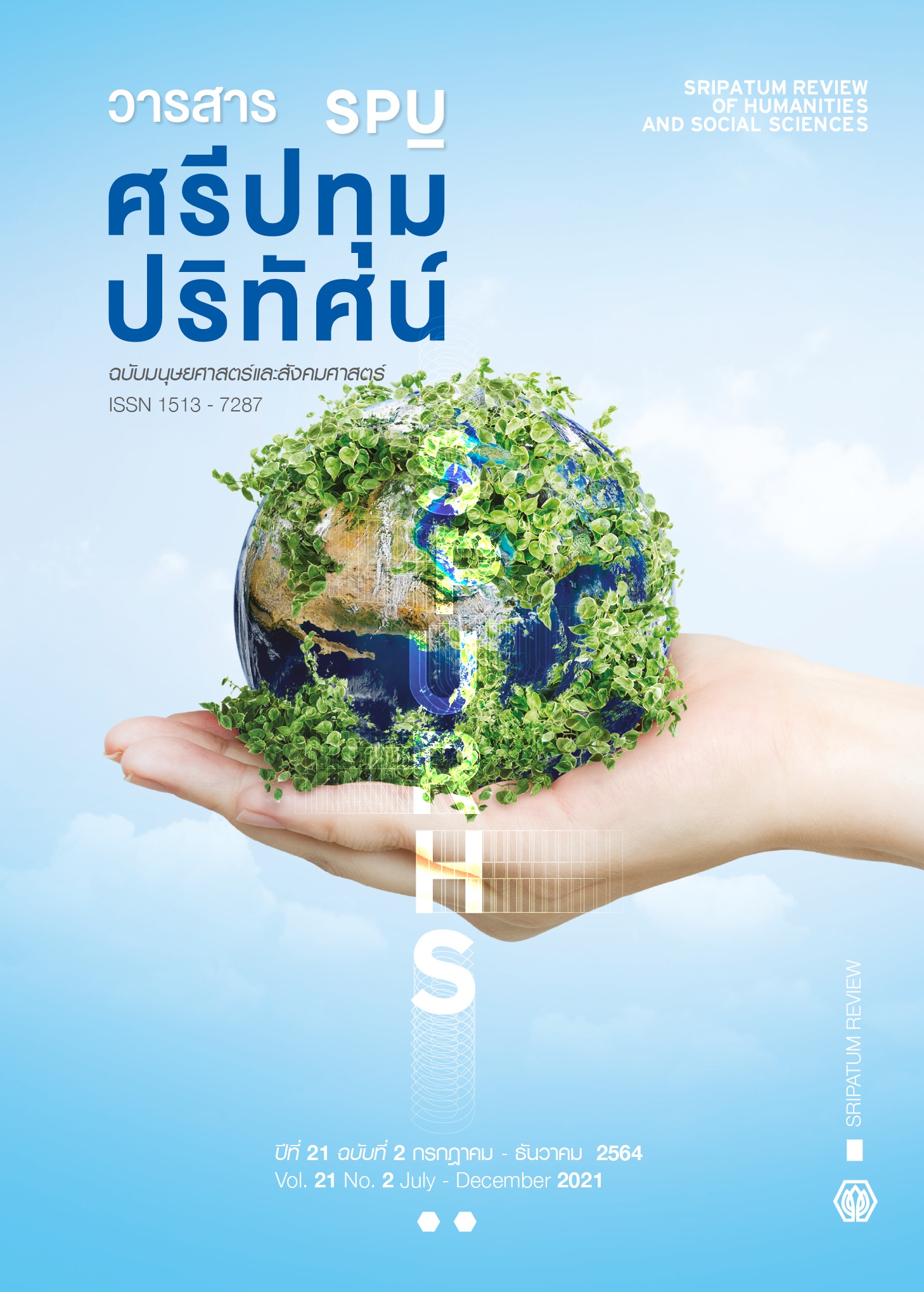Effect of Work from Home, Work Based Social Support, Virtual Work Support, and Work-life Balance on Employees’ Well-being
Main Article Content
Abstract
The aims of this mixed-method research were (1) to develop and validate the causal relationship model of employees’ well-being, and (2) to analyze the effects of work from home, work based social support, virtual work support and work-life balance on employees’ well-being. This study was a mixed-method research involving the quantitative and qualitative research methodologies. In the quantitative study, the research sample consisted of 379 office employees at a consolidated department store. A questionnaire was used to collect data, and then the data were analyzed using structural equation modeling technique. In the qualitative study, the data were collected by interviewing 20 key informants. The data were analyzed with the content analysis method. The findings were as follows: (1) the developed causal relationship model fitted with the empirical data and 96.92 percent of employees’ well-being could be collectively explained by all four independent variables; and (2) work from home had negative effect on employees’ well-being; while virtual work support, work based social support, and work-life balance had positive effects on employees’ well-being.
Article Details
1. กองบรรณาธิการสงวนสิทธิ์ในการพิจารณาและตัดสินการตีพิมพ์บทความในวารสาร
2. บทความทุกเรื่องจะได้รับการตรวจสอบทางวิชาการโดยผู้ทรงคุณวุฒิ แต่ข้อความและเนื้อหาในบทความที่ตีพิมพ์เป็นความรับผิดชอบของผู้เขียนแต่เพียงผู้เดียว มิใช่ความคิดเห็นและความรับผิดชอบของมหาวิทยาลัยศรีปทุม
3. การคัดลอกอ้างอิงต้องดำเนินการตามการปฏิบัติในหมู่นักวิชาการโดยทั่วไป และสอดคล้องกับกฎหมายที่เกี่ยวข้อง
References
Annink, A. (2017). From Social Support of Capabilities for Work-life Balance of Independent Professionals. Journal of Management & Organization, 23(2), 258-276.
Agha, K., Azmi, F. T., and Khan, S. A. (2017). Work-Life Balance: Scale Development and Validation. In: Heras, M. L., Chinchilla, N. and Grau, M. (eds). The Work-Family Balance in Light of Globalization and Technology (pp. 109-130). UK: Cambridge Scholars Publishing.
Allen, T.D., Cho, E., and Meier, L.L. (2014). Work-Family Boundary Dynamics. The Annual Review of Organizational Behavior. Retrieved May 20, 2020 from 10.1146/annurev-orgpsych-031413-091330.
Baral,R., and Bhargava,S. (2010) Work-family Enrichment as a Mediator Between Organizational Interventions for Work-life Balance and Job Outcomes. Journal of Managerial Psychology, 25(3), 274-300.
Beauregard, T. A. (2011) Direct and Indirect Links Between Organizational Work-home Culture and Employee Well-being. British Journal of Management, 22(2), 218-237
Bentley, T.A., Teo S.T.T., McLeod, L., Tan, E., Bosua, R., and Gloet, M. (2016). The Role of Organizational Support in Teleworker Wellbeing: A Socio-technical system approach. Applied Ergonomics, 52(1), 207-215.
Brooks, S. K., Webster, R. K., Smith, L. E., Woodland, L., Wessely, S., Greenberg, N., and Rubin, G. J. (2020). The Psychological Impact of Quarantine and How to Reduce It: Rapid Review of the Evidence. The Lancet, 395(1), 912-920.
Creswell, J., and Creswell, D.J. (2018). Research Design. 5th ed. LA: Sage
Grant, C.A., Wallace, L.M. and Spurgeon, P.C. (2013). An Exploration of the Psychological Factors Affecting Remote E-worker's Job Effectiveness, Well-being and Work-life Balance. Employee Relations, 35 (5), 527-546.
Gottlieb, B., and Bergen, A.E. (2011). Social Support Concepts and Measures. Journal of Psychosomatic Research, 69(5), 511-20.
Hair, J.F., Black, W.C., Babin, B.J. and Anderson, R.E. (2010). Multivariate Data Analysis. 7th ed. New York: Pearson.
House, J.S. and Kahn, R.L. (1985). Measures and Concepts of Social Support in Cohen, S. & Syme, S.L. (Eds.), Social support and health. New York: Academic Press.
Husser J.A,, Mojzisch, A, Niesel, A., and Schulz-Hardt, S. (2010). Ten Years on: A Review of Recent Research on the Job Demand–Control (-Support) Model and Psychological Well-being, Work & Stress. An International Journal of Work, Health & Organisations, 24(1), 1-35.
Kreiner, G. E., Hollensbe, E. C., and Sheep, M. L. (2009). Balancing Borders and Bridges: Negotiating the Work-home Interface via Boundary Work Tactics. Academy of Management Journal, 52(4), 704-730.
Lambe, C. J., Wittmann, C.M., and Robert E.S. (2001). Social Exchange Theory and Research on Business-to-business Relational Exchange. Journal of Business-to-Business Marketing, 8(3), 1–36.
Preacher, K. J., and Coffman, D. L. (2006). Computing Power and Minimum Sample Size for RMSEA [Computer software]. [Online]. Retrieved March 20, 2020 from http://quantpsy.org/.
Pressman S.D., Kraft T., and Bowlin S. (2013) Well-Being: Physical, Psychological, Social. In: Gellman M.D., Turner J.R. (eds) Encyclopedia of Behavioral Medicine. New York: Springer.
Rafnsdottir, G.L., and Stefansson, A.S., (2014). Virtual Work and Work-life Balance for Manager. International Journal of Business and Management, 9(11), 1-12.
Verburg, R.M., Bosch-Sijtsema, P., and Vartiainen, M. (2013). Getting It Done: Critical Success Factors for Project Managers in Virtual Work Settings. International Journal of Project Management, 31(1), 68-79.
World Health Organization. (2020). WHO Director-General's Opening Remarks at the Media Briefing on COVID-19 - 11 March 2020. [Online]. Retrieved May 20, 2020 from https://www.who.int/dg/speeches/detail/who-director-general-s-opening-remarks-at-the-media-briefing-on-covid-19---11-march-2020.


